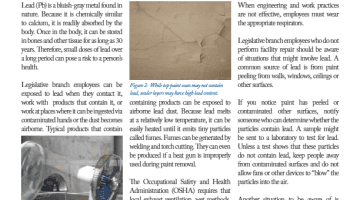Lead (Pb) is a bluish-gray metal found in nature. Because it is chemically similar to calcium, it is readily absorbed by the body. Once in the body, it can be stored in bones and other tissue for as long as 30 years. Therefore, small doses of lead over a long period can pose a risk to a person’s health.
Legislative branch employees can be exposed to lead when they contact it, work with products that contain it, or work at places where it can be ingested via contaminated hands or the dust becomes airborne. Typical products that contain lead are paints and sealants, particularly those made before 1978. Exposures can also occur when working with brass, solder, caulk, and other materials.
Employees who perform sawing, sanding and other mechanical processes on lead containing products can be exposed to airborne lead dust. Because lead melts at a relatively low temperature, it can be easily heated until it emits tiny articles called fumes. Fumes can be generated by welding and torch cutting. They can even be produced if a heat gun is improperly used during paint removal.
The Occupational Safety and Health Administration (OSHA) requires that local exhaust ventilation, wet methods, or other feasible practices be used to limit the inhalation of lead fumes and dusts.
When engineering and work practices are not effective, employees must wear the appropriate respirators.
Legislative branch employees who do not perform facility repair should be aware of situations that might involve lead. A common source of lead is from paint peeling from walls, windows, ceilings or other surfaces.
If you notice paint has peeled or contaminated other surfaces, notify someone who can determine whether the particles contain lead. A sample might be sent to a laboratory to test for lead. Unless a test shows that these particles do not contain lead, keep people away from contaminated surfaces and do not allow fans or other devices to “blow” the particles into the air.

